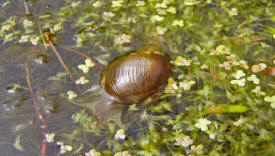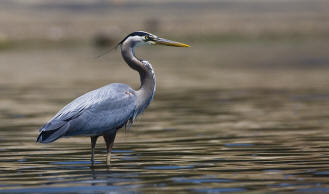Interactions
 The
Echinostoma revolutum is a parasitic organism. It infects the digestive and
reproductive tracts of the organism it infects. The most common host organisms are
birds/mammals, snails, molluscs, and frogs (Sorensen et al. 1997).
The
Echinostoma revolutum is a parasitic organism. It infects the digestive and
reproductive tracts of the organism it infects. The most common host organisms are
birds/mammals, snails, molluscs, and frogs (Sorensen et al. 1997).
The first host organism is a Lymnaea elodes Snail. The parasite uses the stored energy, that the organism has in order to reproduce, as its food sourc. After about three weeks the fecundity of the host organism drops (Sorensen et al. 1997). After about five to six weeks post infection the host no longer produces any eggs. This has been found to lead to extended growth in snails (Sorensen et al. 1997).
Snails that are infected with the Echinostoma revolutum were found to have grown larger than the normal size snail. This occurs because the energy that should have been being used for reproduction instead was being used by the snail to grow larger (Ebert et al. 2004).
The
mortality rate is higher in the snails at two differ ent points
post infection. The
points at which the rates are highest are just shortly after
being infected and after the cercariae were leaving the organism
. There usually is not
any tissue damages to the host snail until over a month after
coming into contact with the parasite (Sorensen et al. 1997).
ent points
post infection. The
points at which the rates are highest are just shortly after
being infected and after the cercariae were leaving the organism
. There usually is not
any tissue damages to the host snail until over a month after
coming into contact with the parasite (Sorensen et al. 1997).
The infection of the host organism by the host organism is not intended to kill the host. By keeping the host from reproducing, this saves a lot of the host’s energy (Ebert, D. et al. 2004). With this extra energy the organism is better able to live while the parasite is feeding off of its energy reserves. This energy is used by the parasite to reproduce and live successfully. Without the leftover energy, the host would be more likely to die prematurely because of all of the energy the fluke is taking from them (Ebert, D. et al. 2004). This would also cause the death for the parasite which would not make this a beneficial relationship for either party involved (Ebert, D. et al. 2004).
 The
final host organism can be any vertebrate animal. This organism is infected by eating a raw snail,
frog, or any other organism that was infected with the Echinostoma revolutum. This includes
humans (Sohn et al. 2011). Humans are most commonly
affected in areas in Asian countries. Symptoms that are expressed by humans that are infected with
this parasite include stomach pains, diarrhea, fatigue and
malnutrition (Sohn et al. 2011). If the case is bad
enough, this parasite can even cause death. With enough worms, the parasites can cause a hole to
form in the intestines, complications of malnutrition and/or
anemia (Sohn et al. 2011).
The
final host organism can be any vertebrate animal. This organism is infected by eating a raw snail,
frog, or any other organism that was infected with the Echinostoma revolutum. This includes
humans (Sohn et al. 2011). Humans are most commonly
affected in areas in Asian countries. Symptoms that are expressed by humans that are infected with
this parasite include stomach pains, diarrhea, fatigue and
malnutrition (Sohn et al. 2011). If the case is bad
enough, this parasite can even cause death. With enough worms, the parasites can cause a hole to
form in the intestines, complications of malnutrition and/or
anemia (Sohn et al. 2011).
This parasitic relationship is not well studied. It is a very common parasite found in school aged children in Cambodia. These children will find a snail or clam in the pond nearby and eat them raw (Sohn et al. 2011). These snails and clams are infected with this parasite and inturn the children consume them and become infected themselves. The only way that the parasite can be detected now is through the feces of the infected human or other host organism (Sohn et al. 2011).
Continue on to the Fun Facts Page...